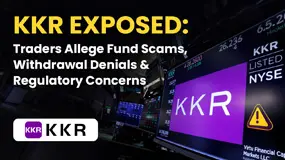简体中文
繁體中文
English
Pусский
日本語
ภาษาไทย
Tiếng Việt
Bahasa Indonesia
Español
हिन्दी
Filippiiniläinen
Français
Deutsch
Português
Türkçe
한국어
العربية
Unveiling the World of Algorithmic Forex Trading Software | How It Works | Pros and Cons
Abstract:Algorithmic forex trading software perfectly combines technical prowess and market efficiency. While it offers numerous advantages, including emotionless trading, 24/5 market monitoring, and rapid execution, it is crucial to recognize the inherent risks and limitations, such as overfitting and high costs.
Algorithmic forex trading perfectly combines technical prowess and market efficiency. While it offers numerous advantages, including emotionless trading, 24/5 market monitoring, and rapid execution, it is crucial to recognize the inherent risks and limitations, such as overfitting and high costs.
If I tell you there is a forex trader who is intelligent, calm, and logical, maintains vigilance 24/5, and executes trades almost immediately when trading opportunities arise, would you immediately hire him as your account manager? I believe the answer is a definite yes.
In reality, there is no such human trader. However, through algorithmic forex trading, you can have all the above qualities and even more.
So, what is algorithmic forex trading? How does it work? What are its characteristics? And how can traders make use of it? Read this article, and we will guide you to explore the answers!
Algorithmic Forex Trading: Definition and History
Algorithmic Forex trading, also known as automated Forex trading or robot Forex trading, is a method that utilizes computer programs and algorithms to execute trades in the Forex market. Algorithmic Forex trading systems can perform various tasks, including generating trade signals, executing trades, managing risks, and conducting real-time monitoring.
The development history of algorithmic trading can be traced back to the late 1970s and early 1980s. The earliest algorithmic trading was primarily focused on stock markets, using simple trading strategies such as moving average crossovers. These systems were mainly developed and used by traders and researchers within financial institutions. With the rise of electronic trading platforms in the 1990s, the Forex market began to introduce electronic trading systems, and algorithmic Forex trading began to take shape during this time. In the 21st century, algorithmic Forex trading experienced rapid development:
Early 2000s
Algorithmic Forex trading was initially applied among institutional investors. Some large financial institutions and fund management companies started utilizing computer programs to execute Forex trading strategies. These early systems mainly relied on technical analysis.
Mid-2000s to early 2010s
With the continuous improvement of trading technology and computing power, high-frequency Forex trading gradually emerged. Some specialized algorithmic Forex trading companies, known as algorithmic Forex brokers, began to rise. These companies focused on using highly complex algorithms to quickly profit from minor price fluctuations.
2010s
Algorithmic Forex trading systems gradually expanded to multiple currency pairs and other financial instruments, realizing multi-asset strategies. The trend of globalization also led to the widespread application of algorithmic Forex trading in different Forex markets.
2020s to the present
Algorithmic Forex trading has benefited from the development of machine learning and artificial intelligence technologies. By employing more advanced models, such as neural networks and deep learning, algorithmic Forex trading systems can adapt more flexibly to market changes.

How Algorithmic Trading Work
After understanding the history of algorithmic forex trading, let's explore its development process. Typically, an effective algorithmic forex trading system goes through the following steps:
Strategy Development: Traders or developers first need to define the trading strategy. This involves selecting appropriate market indicators, technical analysis tools, machine learning models, etc., to establish decision rules. The design of the strategy can be based on various factors, such as price trends, crossover signals of technical indicators, trend analysis, etc.
Algorithm Coding: Translate the trading strategy into executable computer code. This involves converting the logic, rules, and parameters of the strategy into a programming language. Common programming languages include Python, Java, C++, and others.
Backtesting: Before running the algorithm in live markets, conduct backtesting with historical data to evaluate the strategy's performance. Backtesting simulates the algorithm's behavior under past market conditions, helping traders understand its adaptability to different market situations and optimize parameters for improved performance.
Risk Management: Establish risk management rules, including setting stop-loss and take-profit levels, position control, etc. This helps protect the capital and prevent potential large losses.
Connecting to Trading Platform: Connect the written algorithm to the forex trading platform. This is usually done through an Application Programming Interface (API), enabling the algorithm to interact with external markets in real-time.
Real-Time Market Monitoring: Once connected to the trading platform, the algorithm continuously monitors market conditions in real-time. This includes fetching real-time market data, executing trade instructions, and updating position and account information.
Trade Execution: When the conditions of the trading strategy are met, the algorithm automatically executes buy or sell orders. The execution speed is typically in milliseconds, allowing the algorithm to respond quickly to market changes.
Real-Time Risk Management: While executing trades, the algorithm performs real-time risk management. This may involve dynamically adjusting stop-loss and take-profit levels, controlling position sizes, and other risk mitigation measures.
Real-Time Monitoring and Reporting: Traders need to monitor the algorithm's execution in real-time, ensuring it operates as expected. Additionally, reports are generated and the algorithm's performance is analyzed for further optimization and improvement.
Optimization and Adjustment: Based on actual market performance, traders may need to regularly optimize and adjust the algorithm. This includes considering changes in market conditions, updating model parameters, or adjusting strategy logic.
Types of Algorithmic Trading Strategies
Due to the volatility of the market and the limited market capacity for each trading strategy, traders have developed various types of strategies. These types of algorithmic forex trading systems can be used individually or in combination to form more complex trading strategies.
Trend Following Systems
These systems execute trades by identifying and following market trends. When a clear trend emerges in the market, trend-following systems attempt to capture and follow the direction of the trend.
Mean Reversion Systems
Based on mean reversion, these systems assume that prices will fluctuate around their average levels. These systems typically execute trades when prices deviate from the average, expecting prices to revert to the mean.
Statistical Arbitrage Systems
Statistical arbitrage systems execute trades based on price differences between different markets or assets. These systems aim to profit from short-term price inconsistencies and often involve trading between two or more correlated assets.
High-Frequency Trading Systems (HFT)
HFT systems conduct a large number of trades in extremely short time frames, typically in milliseconds or microseconds. These systems leverage rapid execution and small market fluctuations to generate profits.
Machine Learning and Artificial Intelligence Systems
Using machine learning and AI technologies, these systems learn from historical data and automatically adjust trading strategies. They can adapt to evolving market conditions and strive to enhance predictive accuracy.
Event-Driven Systems
Event-driven systems execute trades when specific events occur, such as the release of economic data or corporate financial reports. These systems often make rapid decisions after an event is triggered.
Market Maker Systems
Market maker systems provide both buy and sell prices simultaneously, creating liquidity and profiting from the bid-ask spread. These systems contribute to maintaining market liquidity.
Arbitrage Systems
Arbitrage systems profit from price differences between different markets, exchanges, or other assets. Arbitrage systems may include spatial arbitrage, temporal arbitrage, and other forms.
Cointegration Trading Systems
Cointegration trading systems are based on cointegration relationships, executing trades by monitoring the price trends of two or more correlated assets.
Quantitative Investment Systems
These systems use mathematical models and statistical principles to determine trading signals and automate trading decisions based on historical data.
Platforms Supporting Algorithmic Trading
Many forex trading platformssupport algorithmic forex trading and provide corresponding tools and environments for traders to develop, test, and execute their automated trading strategies. Here are some major platforms that support algorithmic forex trading:
MetaTrader 4 (MT4) and MetaTrader 5 (MT5):
MT4 and MT5 are among the most popular forex trading platforms, supporting a wide range of automated trading features. Traders can use MetaEditor to write and test custom trading scripts, and they can also implement automated trading through various third-party expert advisors available in the market.
cTrader:
cTrader is another popular forex trading platform that supports algorithmic trading. It provides cAlgo, a tool for developing custom indicators and trading robots.
NinjaTrader: NinjaTrader is a versatile trading platform that supports forex, futures, and stock trading. It has robust automation and customization features, allowing traders to write custom strategies and indicators using C#.
TradeStation
TradeStation is a comprehensive trading platform that offers automation features for forex, futures, and stock trading. It supports the use of EasyLanguage to write custom strategies.
ZuluTrade
ZuluTrade is a forex social trading platform that allows traders to automatically copy the trades of other successful traders. It provides a social experience for automated trading.
ProRealTime
ProRealTime is a charting and trading platform that supports forex, stock, and futures markets. It has automation features and allows the use of ProRealCode to write custom indicators and strategies.
The Pros and Cons
The effectiveness of algorithmic forex trading depends on the trader's needs, market conditions, and the design and execution of the algorithm itself. It has numerous advantages:
Advantages
Fast Execution: Algorithmic trading systems can execute trades in milliseconds or microseconds, much faster than manual trading, enabling them to capture rapidly changing market opportunities.
Automation and Discipline: Algorithmic trading systems follow predetermined rules and parameters when executing trades, unaffected by emotions and subjective judgment. This makes it easier to maintain discipline and avoid human errors.
Handling Large Data Sets: Algorithmic trading systems can simultaneously process and analyze large amounts of market data, identifying and exploiting more trading opportunities than manual traders who may be limited by information overload.
Diversification of Strategies: By programming different trading strategies, algorithmic trading can run multiple strategies simultaneously, achieving better risk diversification.
Real-Time Monitoring and Adjustment: Algorithmic trading systems can monitor market conditions in real-time and adjust trading strategies based on predefined rules to adapt to different market conditions.
Disadvantages
Despite the many advantages listed above, algorithmic forex trading also comes with some potential drawbacks and risks. Traders considering the use of algorithmic trading systems should be aware of the following disadvantages:
Technical Risks: Algorithmic trading systems are highly dependent on technology. Hardware failures, network issues, or software errors can lead to execution problems and even losses.
Risk of Over-Optimization: Relying too heavily on historical data for optimization can lead to overfitting, where the algorithm performs well on historical data but poorly on new data in the future.
Market Changes: Changes in market conditions may render previously effective algorithms ineffective in new environments. Algorithms need constant updates and adjustments to adapt to evolving markets.
Complexity and Development Costs: Designing and maintaining algorithmic trading systems require highly specialized technical knowledge, leading to potentially high development costs. Additionally, complex algorithms may be challenging to understand and explain.
Lack of Consideration for Fundamentals: Some algorithms may overly focus on technical indicators, neglecting fundamental factors. This can lead to suboptimal results in certain market situations.
Traders should carefully weigh these advantages and disadvantages when deciding whether to implement algorithmic forex trading, considering their specific goals, risk tolerance, and the dynamic nature of the forex market.
Bottom Line
In summary, algorithmic forex trading utilizes computer programs and algorithms to execute transactions in the forex market, offering various advantages. Fast execution speed, automation and discipline, ability to handle large amounts of data, and diversified strategies are its key benefits. Traders can build an effective algorithmic forex trading system through steps such as strategy development, coding algorithms, backtesting, and risk management. Different types of strategies, including trend tracking, mean reversion, statistical arbitrage, etc., allow traders to choose strategies that suit their risk preferences and market conditions.
However, the use of algorithmic forex trading systems comes with potential risks and drawbacks. Technical risks, over-optimization risks, market changes, complexity and development costs, and the oversight of fundamental factors are all aspects that need attention. Traders deciding to employ algorithmic forex trading systems should carefully weigh their advantages and disadvantages and handle potential risks with caution. Overall, algorithmic forex trading provides traders with a more scientific and systematic approach to trading, but success still requires continuous learning and adjustments to adapt to the ever-changing market conditions.
Disclaimer:
The views in this article only represent the author's personal views, and do not constitute investment advice on this platform. This platform does not guarantee the accuracy, completeness and timeliness of the information in the article, and will not be liable for any loss caused by the use of or reliance on the information in the article.
Read more

KKR Exposed: Traders Allege Fund Scams, Withdrawal Denials & Regulatory Concerns
Do you witness a negative trading account balance on the KKR broker login? Does the broker prevent you from withdrawing your funds after making profits? Do you need to pay an extra margin for withdrawals? These trading issues have become common for traders at KKR. In this KKR broker review article, we have elaborated on the complaints. Take a look!

IG Launches 5% Cashback Offer for New UK Customers
IG cashback offer UK 2025 gives investors up to £100 back. Compare the best UK investment platforms with cashback today.

In-Depth Review of MH Markets Regulation and Compliance Profile – What Traders Should Really Know
This in-depth analysis provides a data-driven examination of the MH Markets regulation and compliance profile. Drawing primarily on verified data from the global broker inquiry app WikiFX, supplemented by public records, we will dissect the broker's multi-jurisdictional licensing, evaluate the real-world protections offered to traders, and interpret the warnings and ratings that define its standing in the competitive forex and CFD landscape.

In-Depth Stonefort Securities Commission Fees and Spreads Analysis for 2025
This comprehensive Stonefort Securities commission fees and spreads analysis aims to cut through the noise. We will dissect the broker's complete cost structure, from the spreads on its Elite account to its commission policies and the potential for hidden non-trading fees. Explore more.
WikiFX Broker
Latest News
Is Purple Trading a Scam? Honest User Reviews Reveal the Truth
Kraken Review: A Tale of Unsolved Withdrawal Issues & Poor Customer Support Service
KKR Exposed: Traders Allege Fund Scams, Withdrawal Denials & Regulatory Concerns
IG Launches 5% Cashback Offer for New UK Customers
Forex Trading During Pakistan Market Hours: Best Time to Trade
Malaysia’s SkyLine Guide Top 25 Brokers Are Out!
In-Depth Stonefort Securities Commission Fees and Spreads Analysis for 2025
EPlanet Broker Review: Detailed Look at Regulation, User Experiences & Reported Complaints
In-Depth Review of MH Markets Regulation and Compliance Profile – What Traders Should Really Know
Trading Suspended at CME Group Today due to Cooling Issue
Currency Calculator



